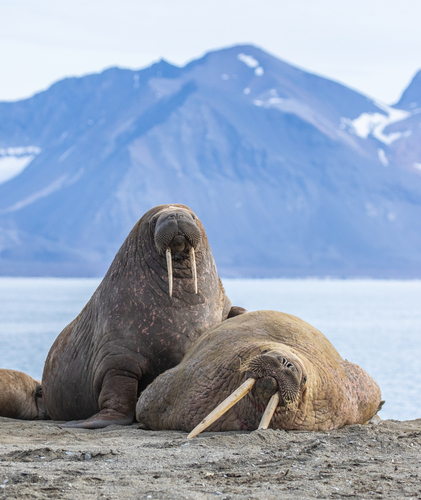
Walrus
Odobenus rosmarus, the walrus, is an Arctic giant with iconic tusks and a social nature. These creatures gracefully glide through icy waters, sustaining marine ecosystems by feeding on sea floor invertebrates. Their tusks serve as tools for ice navigation, making them magnificent symbols of polar resilience.
40 years
Lifespan
800.0 - 1700.0 kg
Weight
Length: 2.7 - 3.66 m
Size
Brown, Grey
Color
6-10 years
Age of Sexual Maturity
2 years
Age of Weaning
22 mph
Top Speed
Vulnerable
Conservation Status
Unknown
Population Trend
Characteristics
The walrus, or Odobenus rosmarus, is a large marine mammal distinguished by its long tusks, whiskered face, and massive, blubber-covered body. It inhabits Arctic and sub-Arctic regions, often forming large social groups on ice. Walruses are known for their unique ability to use their tusks to haul themselves onto ice and their vital role in the marine ecosystem as benthic feeders.
Distribution Range of the Walrus
The walrus (Odobenus rosmarus) is native to the Arctic and sub-Arctic regions of the Northern Hemisphere. Its geographical distribution includes the coastal areas and continental shelf regions of the Arctic Ocean and sub-Arctic seas of the Northern Hemisphere. The species is predominantly found in the areas around the Arctic Circle, including the coasts and islands of Russia, Greenland, Canada, and Alaska (USA), as well as in the Bering, Chukchi, and Laptev seas.
Walrus's Habitat
Environmental Conditions
Walruses inhabit cold, icy waters where sea ice is present, which they use as a resting platform and for birthing and raising their young. They are commonly found near the shallow waters of the continental shelf, where they can easily dive to forage for food. The climate in these regions is characterized by cold temperatures, seasonal sea ice, and long winters with short, cool summers.
Ecological Niche
Walruses are marine mammals that occupy a niche as benthic feeders, primarily consuming mollusks such as clams, as well as other invertebrates found on the ocean floor. Their large tusks are used to haul out onto ice and to forage by disturbing the ocean floor. They play a crucial role in the Arctic marine ecosystem, influencing the benthic community structure and serving as prey for polar bears and orcas.
Copyright @ Nature Style Limited. All Rights Reserved.
 English
English